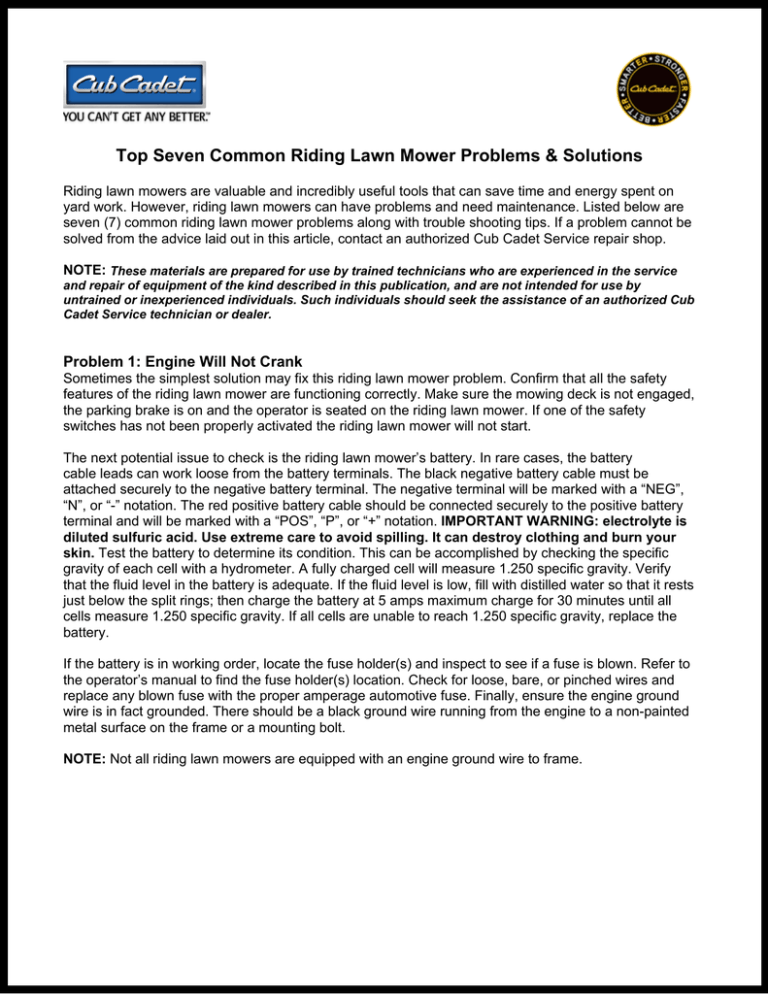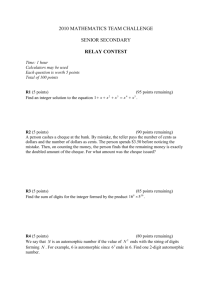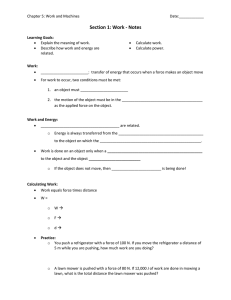Top Seven Common Riding Lawn Mower Problems
advertisement

Top Seven Common Riding Lawn Mower Problems & Solutions Riding lawn mowers are valuable and incredibly useful tools that can save time and energy spent on yard work. However, riding lawn mowers can have problems and need maintenance. Listed below are seven (7) common riding lawn mower problems along with trouble shooting tips. If a problem cannot be solved from the advice laid out in this article, contact an authorized Cub Cadet Service repair shop. NOTE: These materials are prepared for use by trained technicians who are experienced in the service and repair of equipment of the kind described in this publication, and are not intended for use by untrained or inexperienced individuals. Such individuals should seek the assistance of an authorized Cub Cadet Service technician or dealer. Problem 1: Engine Will Not Crank Sometimes the simplest solution may fix this riding lawn mower problem. Confirm that all the safety features of the riding lawn mower are functioning correctly. Make sure the mowing deck is not engaged, the parking brake is on and the operator is seated on the riding lawn mower. If one of the safety switches has not been properly activated the riding lawn mower will not start. The next potential issue to check is the riding lawn mower’s battery. In rare cases, the battery cable leads can work loose from the battery terminals. The black negative battery cable must be attached securely to the negative battery terminal. The negative terminal will be marked with a “NEG”, “N”, or “-” notation. The red positive battery cable should be connected securely to the positive battery terminal and will be marked with a “POS”, “P”, or “+” notation. IMPORTANT WARNING: electrolyte is diluted sulfuric acid. Use extreme care to avoid spilling. It can destroy clothing and burn your skin. Test the battery to determine its condition. This can be accomplished by checking the specific gravity of each cell with a hydrometer. A fully charged cell will measure 1.250 specific gravity. Verify that the fluid level in the battery is adequate. If the fluid level is low, fill with distilled water so that it rests just below the split rings; then charge the battery at 5 amps maximum charge for 30 minutes until all cells measure 1.250 specific gravity. If all cells are unable to reach 1.250 specific gravity, replace the battery. If the battery is in working order, locate the fuse holder(s) and inspect to see if a fuse is blown. Refer to the operator’s manual to find the fuse holder(s) location. Check for loose, bare, or pinched wires and replace any blown fuse with the proper amperage automotive fuse. Finally, ensure the engine ground wire is in fact grounded. There should be a black ground wire running from the engine to a non-painted metal surface on the frame or a mounting bolt. NOTE: Not all riding lawn mowers are equipped with an engine ground wire to frame. © Cub Cadet www.cubcadet.com 1 Problem 2: Engine Cranks, But Does Not Start If the riding lawn mower will not start, check the fuel level. The engine will not fire if there is not enough fuel in the carburetor. It is also possible the fuel line is clogged or blocked. Clean the line and replace the fuel filter to solve this problem. Make sure the throttle and/or choke is in the proper position. This position can vary from model to model of riding lawn mower. Consult the operator’s manual for the proper positioning of the choke and throttle for the riding lawn mower in question. Faulty spark plugs or disconnected wires can also cause the engine to crank but not start. Run a diagnosis on the spark plug wire connection by using a spark plug tester to see if any plugs are faulty. Clean the gap, making sure it is set properly or replace any faulty spark plugs. Problem 3: Engine Is Smoking The most common cause of an engine smoking is having too much oil. Examine the oil level and remove any excess oil if overfilled. The problem should go away once the excess oil burns off. If the smoking persists, it could be possible the engine is losing its crankcase vacuum. Loss of crankcase vacuum can be caused by a broken or improperly seated dipstick, dipstick tube, or valve cover as well as a defective engine breather assembly or other internal engine damage. Replace any defective parts to restore crankcase vacuum pressure. Problem 4: Unusual and Excessive Vibration Blades, pulleys and spindles should not be bent or damaged. Mowing over a large object such as rocks, roots, sewer lids etc. can cause damage to the parts. Any damaged parts should be replaced. A twisted or damaged belt may also be the culprit. All belts should be in good shape and properly routed. Replace the belt if it’s torn or shows signs of wear. Vibrations can also be caused by loose or missing mounting bolts, running the engine at a low RPM, or an improperly adjusted cutting deck. Problem 5: Bagging, Discharging, or Mulching Poorly There are a few actions that can be taken to minimize problems with the bagging, discharging and mulching. First, check the engine speed. The engine must be operating at full throttle for the bagging, discharging or mulching functions to work properly. Proper set-up of the deck is critical to the quality of cut. The deck should be level side to side and always lower in the front than the back by 3/8 of an inch. If that does not solve the problem, sharpen or replace the mower blades. NOTE: Make sure the proper blade is being used for the correct application. Operating conditions such as wet or exceptionally tall grass can cause poor functionality. To remedy these situations, always allow the lawn to dry prior to cutting, and if the grass is too tall, mow with the deck at a higher setting before mowing at the normal level. Try mowing at a slower rate to get a better and cleaner cut. Lastly, clean out any dirt and debris that has built up on the underside of the deck. © Cub Cadet www.cubcadet.com 2 Problem 6: Mower Will Not Cut In Reverse This is not a problem at all -- it is a safety feature. The cutting deck must be disengaged before the tractor can be shifted into reverse. However if the Cub Cadet riding lawn mower was produced in 2005 or later it is equipped with RevTEK™ reverse mowing technology. This allows the operator to mow in reverse. Refer to the operator’s manual for instructions. Problem 7: Tractor Will Not Move Freely In Neutral Check the operating manual to ensure the transmission relief valve is in the proper position. If it does not move in neutral, make sure the brake is fully releasing. © Cub Cadet www.cubcadet.com 3



